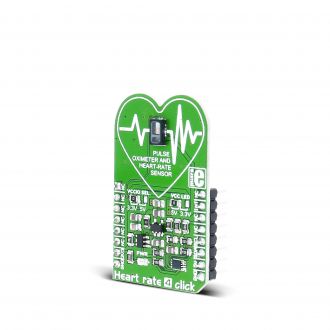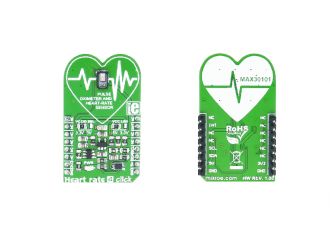
We strongly encourage users to use Package manager for sharing their code on Libstock website, because it boosts your efficiency and leaves the end user with no room for error. [more info]

Rating:
Author: MIKROE
Last Updated: 2019-07-30
Package Version: 1.0.0.1
mikroSDK Library: 1.0.0.0
Category: Biometrics
Downloaded: 7854 times
Not followed.
License: MIT license
Heart rate 4 click carries the MAX30101 high-sensitivity pulse oximeter and heart-rate sensor from Maxim Integrated. The click is designed to run on either 3.3V or 5V power supply. It communicates with the target MCU over I2C interface, with additional functionality provided by INT pin on the mikroBUS line.
Do you want to subscribe in order to receive notifications regarding "Heart rate 4 click" changes.
Do you want to unsubscribe in order to stop receiving notifications regarding "Heart rate 4 click" changes.
Do you want to report abuse regarding "Heart rate 4 click".

Library Description
The library covers all the necessary functions that enables the usage of the Heart rate 4 Click board. It initializes and defines the I2C bus driver and drivers that offer a choice for writing and reading and setting a new value. Also, user can set, clear or check many different interrupts, as well as read from FIFO register.
Key functions:
void heartrate4_setDefaultSettings() - Function is used to apply default settings.uint8_t heartrate4_getInt1() - Function is used to read the main interrupt group.uint32_t heartrate4_getRedVal() - Function is used to read the RED value.Examples description
The application is composed of three sections :
void applicationTask()
{
if( heartrate4_getInt1() & 0x40 )
{
redSamp = heartrate4_getRedVal();
if( redSamp > 0 && redSamp < 32000 )
{
mikrobus_logWrite( "Place Finger On Sensor", _LOG_LINE );
}
else if( redSamp != 0 )
{
LongWordToStr( redSamp, logTxt );
Ltrim( logTxt );
mikrobus_logWrite( "Heart rate : ", _LOG_TEXT );
mikrobus_logWrite( logTxt, _LOG_LINE );
}
mikrobus_logWrite( "------------------------------", _LOG_LINE );
Delay_ms( 1000 );
}
else
{
Delay_ms( 1 );
}
}
Other mikroE Libraries used in the example:
Additional notes and informations
Depending on the development board you are using, you may need USB UART click, USB UART 2 click or RS232 click to connect to your PC, for development systems with no UART to USB interface available on the board. The terminal available in all MikroElektronika compilers, or any other terminal application of your choice, can be used to read the message.
